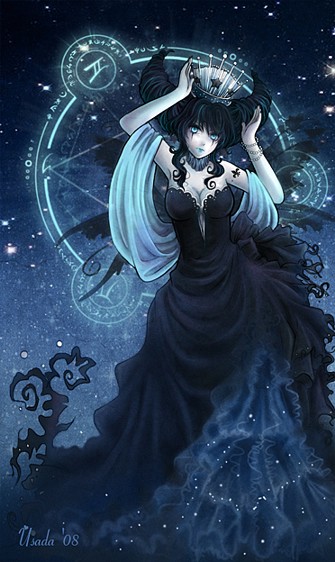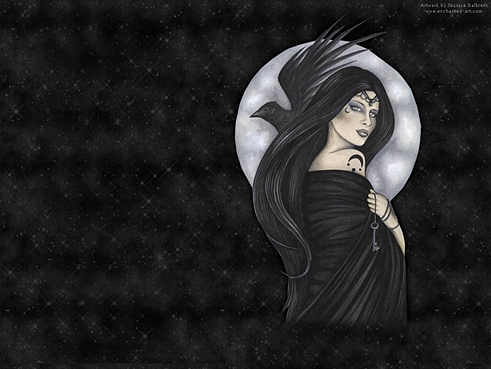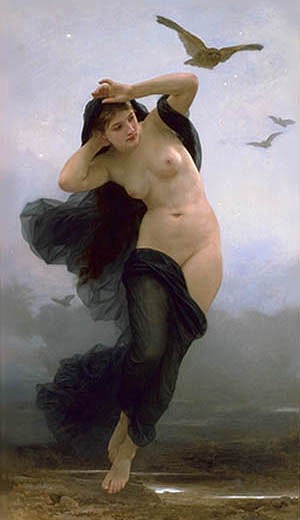Lessico
Notte

In greco Nýx:
dea dell'antica religione greca. Č una madre primordiale, ma in senso
negativo rispetto a Gea (la Terra), essendo autrice degli attributi negativi
della condizione umana, intesi come altrettante personificazioni mitiche: l'illusorietŕ
(Hýpnos, il Sonno, e la famiglia dei Sogni), la fatalitŕ (Móros, le Moire,
le Kéres, Nemesi), il disintegrante principio motore (Éris, la discordia), i
malanni e i vizi (Mómos, il Biasimo; Oizýs, la Miseria; Apate, la Frode;
Philótes, la Lussuria). Sotto il profilo cosmologico Notte era madre delle
Esperidi![]() , collegate con l'“umbratile” estremo Occidente e dunque con il
regno di Notte; suo sposo era l'infero Erebo.
, collegate con l'“umbratile” estremo Occidente e dunque con il
regno di Notte; suo sposo era l'infero Erebo.
Nyx

In Greek mythology, Nyx (Νύξ, Nox in Roman translation) was the primordial goddess of the night. A shadowy figure, Nyx stood at or near the beginning of creation, and was the mother of personified gods such as Hypnos (sleep) and Thánatos (death). Her appearances in mythology are sparse, but reveal her as a figure of exceptional power and beauty.
In Hesiod's Theogony, Nyx is born of Chaos; her offspring are many, and telling. With Erebus the deity of shadow and darkness, Nyx gives birth to Aether (atmosphere) and Hemera (day). Later, on her own, Nyx gives birth to Momus (blame), Ponos (toil), Moros (fate), Thanatos (death), Hypnos (sleep), Charon (the ferryman of Hades), the Oneiroi (dreams), the Hesperides, the Keres and Fates, Nemesis (retribution), Apate (deception), Philotes (friendship), Geras (age), and Eris (strife). In his description of Tartarus, Hesiod says further that Hemera (day), who is Nyx's daughter, left Tartarus just as Nyx entered it; when Hemera returned, Nyx left. This mirrors the portrayal of Ratri (night) in the Rig-Veda, where she works in close cooperation but also tension with her sister Ushas (dawn).
In Book 14 of Homer's Iliad, there is a quote by Hypnos, the minor god of sleep, in which he reminds Hera of an old favor after she asks him to put Zeus to sleep. He had once before put Zeus to sleep at the bidding of Hera, allowing her to cause Heracles (who was returning by sea from Laomedon's Troy) great misfortune. Zeus was furious and would have smitten Hypnos into the sea if he had not fled to Nyx, his mother, in fear. Hypnos goes on to say that Zeus, fearing to anger Nyx, held his fury at bay, and in this way Hypnos escaped the wrath of Zeus.

Nyx took on an even more important role in several fragmentary poems attributed to Orpheus. In them, Nyx, rather than Chaos, is the first principle. Nyx occupies a cave or adyton, in which she gives oracles. Kronos - who is chained within, asleep and drunk on honey - dreams and prophesies. Outside the cave, Adrastea clashes cymbals and beats upon her tympanon, moving the entire universe in an ecstatic dance to the rhythm of Nyx's chanting. Phanes - the strange, monstrous, hermaphrodite Orphic demiurge - was the child or father of Nyx. Nyx is also the first principle in the opening chorus of Aristophanes' Birds, which may be Orphic in inspiration. Here she is also the mother of Eros. In other texts she may be the mother of Charon (with Erebus), and Phthonus "envy" (with Dionysus?).
The theme of Nyx's cave or house, beyond the ocean (as in Hesiod) or somewhere at the edge of the cosmos (as in later Orphism) may be echoed in the philosophical poem of Parmenides. The classical scholar Walter Burkert has speculated that the house of the goddess to which the philosopher is transported is the palace of Nyx; this hypothesis, however, must remain tentative.
There is also rumor that Nyx gave birth to her reincarnation, a son whose name would also be Nyx. But she gave birth to twins, having a daughter as well, who was named Hemera, "Day". The text implied that Hemera was not the sister of Aether, but the sister of Nyx's reincarnation.
In Greece, Nyx is only rarely the focus of cults. According to Pausanias, she had an oracle on the acropolis at Megara. More often, Nyx lurks in the background of other cults. Thus there was a statue called "Nyx" in the Temple of Artemis at Ephesus. The Spartans had a cult of Sleep and Death, conceived of as twins. Cult titles composed of compounds of nyx- are attested for several gods, most notably Dionysus Nyktelios "nocturnal" and Aphrodite Philopannyx "who loves the whole night".
On June 21, 2006, the International Astronomical Union renamed one of Pluto's recently discovered moons (S/2005 P 2) to Nix, in honor of Nyx. The name was spelled with an "i" instead of a "y", to avoid conflict with the asteroid 3908 Nyx. In 1997, the International Astronomical Union officially approved the name NYX for a Mons (Mountain/Peak) feature on the planet Venus. NYX Mons is located at 30 degrees North Latitude, and 48.5 degrees Longitude on the Venusian surface. The feature possesses a diameter of 875 kms., and is attributed to NYX, the Greek Goddess of Night of Greek Mythology. A map of NYX Mons on Venus can be viewed at Map of NYX Mons - V9 Quad - Bell Regio.

Nyx, goddess of the night
by William-Adolphe Bouguereau - La Nuit (1883)
Children of Nyx
By Erebus, the primeval Darkness
Eros Lust, Love, Intercourse
Aether
Charon
Hemera
Styx (but also said to be a daughter of Oceanus and Tethys).
Epiphron
By parthenogenesis
Apate Deceit
Ker, Keres Fates of death
Momos Blame, mockery, gaiety
Moros Doom.
Oizys Misery
Oneiroi Dreams
Philotes Pleasure of love, friendship
Thanatos Death
Eris Strife or Spite
Geras Old Age
Hypnos Sleep
Nemesis Retribution
Hesperides
Phanes
By Uranus
Lyssa Madness
By Cerberus
The hellhounds